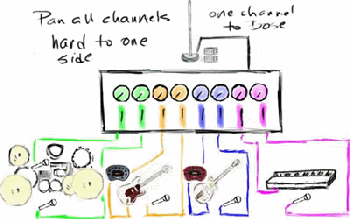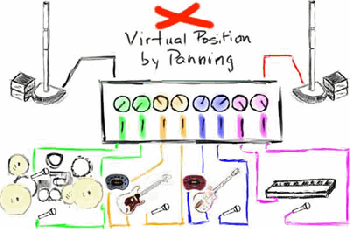Can I Use It as a PA
Contents
Can I use the L1 as a PA
The short answer is yes! This question comes up frequently in various forms in the discussion here. While Bose recommends one system per performer, this doesn't mean that the system can't be run as a conventional PA. I've done it on the road to getting to the ideal, and while having more systems is better you can get great sound running several inputs into a mixer into a Bose system.
One L1 with a Mixer
|
Depending on the size of the venue, type of music you are playing and the ambient noise level, you can run a single system with a mixer. It will sound better than most conventional systems. General Bose guidelines apply here for venues up to 300-500 people. Scan through the messages in the Bose® Pro Portable PA Community and you will find many postings from performers (solo, duos, with and without backing tracks as well as ensembles for four and more). |
Two L1 s with a Mixer
Benefits
- For the Audience: Greater separation of instrument and vocal voicings. This is significant as it helps with Localization
- For the Performers: Greater separation of the voicings means better monitoring. It is more likely that an individual performer will be able to hear his/her contribution to the mix when there are fewer voices in the mix (L1 closest to him/her.
Lesser Benefits
- Because of the near 170° horizontal dispersion with the L1 you don't get a lot more coverage from two L1 s as compared to one. You may get a better sense of spaciousness.
- Having two L1 s should be louder, does not get you twice the perceived volume.
The next three sketches address this.
Best: Pan Hard Left / Hard Right
|
You want to run the signal for each input into the system closest to it. It sounds simple, and it is. The net result is that everyone in the room, regardless of their position gets great sound, and a reasonable correlation between what they see and hear. This is Localization You will get a much better sense of sight and sound correlation with a system for every player, but until you get to that point, this will work. The coloured controls on the mixer are the pan pots. Shown here, the four on the left are panned hard left, and the four on the right are panned hard right. |
Avoid: Dual Mono
Quoting Cliff-at-Bose This particular setup is deeply ingrained in the amplified music culture as the Way We All Do Things, i.e., a PA is always set up on either side of the artists{s}, always has been. That's how we do it. Actually, this approach works better with a typical FOH system as everyone in the audience is much more aware of the system they are closer to (it's louder), due to the ubiquitous inverse-square law of sound radiation (loud up close, quiet far away). And, of course, the problems associated with this approach are discussed in endless detail throughout this forum (bleeding ears, disconnected sight/sound of the performance, nobody onstage knows how they sound in the audience, etc).
Our system has such a gradual change in sound pressure with distance that a pair of systems are clearly and more equally heard way off-axis. This is the quality that gives a pair of L1's such a wide stereo image "sweet spot". It's also a quality that leads to bad dual-mono. In a dual-mono setup where, say, the vocal is center-panned, if you are off-axis, you might hear both systems equally in level, but they will arrive at your ears at different times, corresponding to the difference in distances between the straight-line paths of the two L1's. At a half-wavelength path difference, you will get a complete cancellation where you are listening and above this frequency, you will get, alternatively, reinforcement, then cancellation and so on as frequency goes higher. You will also get a horizontal polar pattern that starts to look like one of those cartoon-character gloves. These are called "lobes" or "fingering" and the higher you go in frequency, more lobes (or fingers) will show up. And so, as you walk in an arc around the pair, you will hear sound get loud, soft, loud, soft and so on. In contrast, a single L1 has an almost perfect, arc-like polar pattern throughout most of its range.
As an example, if the path difference between L1's is a foot where you are standing, you will start the lobey behaviour at the half-wave of a 2 foot wavelength frequency, or ~500 Hz. Way way above this frequency (like 5000 Hz, or upper midrange), the lobes and interference cancellations are so dense that it almost sounds like music. This behaviour sets up two very unpleasant qualities that are easy to hear. One is that off-axis, sound will get duller and more indistinct (blurry or vague) the more you move in this direction. Right up the middle it's fine, where the path differences are negligible. The other thing this sets up is an unpredictable feedback-producing sound field due to all the lobes. Depending on where your microphone is, you might have a lot of feedback at some frequencies and none at others. If you move only a little bit, you'll get feedback and no-feedback at a totally different frequencies. All in all, a dual-mono system might give you a little more level, but not everywhere. It isn't pretty.
This is why one system always sounds better everywhere than two. And so two independent systems is best for two separate performers. Because they are not related ("incoherent" or harmonically unrelated), they can't interfere with each other and you hear the separation and individual localization everywhere. Interestingly, the idea to use a microphone and pickup, both on the same instrument (guitar), might be good. They will be harmonically related in some way. I never heard of this being done but it would be worth a try in wide stereo. Might be Monster, might be Munster. Go try.
Note from User:Chris-at-Bose: If you do run dual mono, maintain at least 20 feet (6 metres) between the L1 s. See: Phase Cancellation
Avoid: Virtual Position by Panning
I thought I was being clever by trying to position everyone in the mix using the pan pots. Notice the indicators on the mixer.
Cliff-at-Bose reminded me:
Dual mono means the same signal coming out of two sources, so anything panned up the middle is dual mono. Good for the audience up the middle, "not that great" for those off-axis. Unfortunately, our system is worse at this than an inverse-square-law system. Better to pan hard left and right. Make sense?
When I pressed the point about virtual positioning...
Virtual placement will vary all over the audience. Again, great up the middle, gets worse as you get more off axis. You should try all this yourself with some simple recordings (like solo voice, solo guitar, etc) off a multitrack and walk around the room. This will not show up big in a small room (like in a studio control room). But in a place you might play it will.
Don't take my word for this. Go do it and then you can speak with a True Knowledge, only gained by being there, doing that.
Note from User:Chris-at-Bose: If you do run dual mono, maintain at least 20 feet (6 metres) between the L1 s. See: Phase Cancellation



